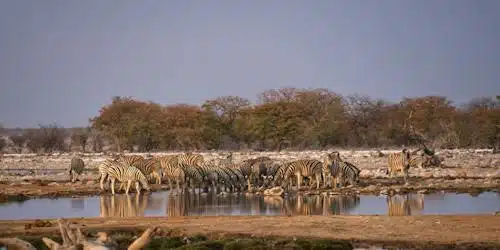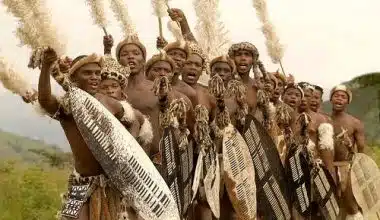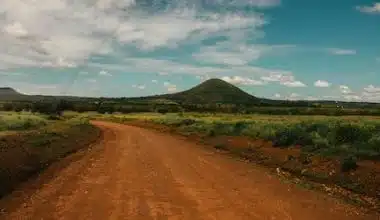Africa is home to a variety of ecosystems, including grasslands, deserts, forests, and jungles. It is the second-largest continent after Asia and is home to a wide variety of stunning and threatening animals of all sizes, both day and night. Read on to learn more about the most dangerous South African animals in the savannah.
These include many species that are exclusive to Africa, such as birds, insects, reptiles, and mammals. It is a well-liked site for both safari enthusiasts and animal researchers due to its biodiversity. In addition to more than 60 carnivore species, 100,000 insect species, 3,000 freshwater fish species, and more than 2,600 bird species, it is home to more than 1,100 distinct mammal species. 15% to 20% of all insects worldwide are found in their populations.
There are no official African animals that represent the entire continent because Africa is made up of numerous nations, each with its own unique culture, language, and ecosystem. As a result, every nation has an official national animal; however, some share the same national animal with other nations or have many national animals.
Distinct African Animals
To live in the wild, all animals—big and small—need affection and gentle care. Like humans, newborn animals are defenseless and dependent on their parents to provide for their needs in terms of protection and nourishment. The animal kingdom is home to a wide variety of species, including fish, amphibians, birds, mammals, and reptiles. Each has its own special method of raising its young.
Animal mothers raise their young until they are ready to live independently, just like our parents do. While some young animals stay with their parents for their whole lives, others take up to six months to gradually separate from them.
Let’s have a look at some extraordinary African animals:
#1. Lion
Native to Africa and India, the lion (Panthera leo) is a big member of the Panthera genus of cats. Being the most well-known animal symbol in human civilization, it has appeared in numerous paintings and sculptures, on national flags, and in modern movies.
#2. Rhino
Unfortunately, rhinos are the most endangered of all the wonderful animals in Africa. The hook-lipped black rhino and the wide-mouthed white rhino are the two species of rhinos found in Africa. A newborn rhino calf can weigh up to 45 kg at birth, and for the first two to three years of life, they are entirely dependent on their mother.
#3. Elephant
Elephants are not only the largest land mammal in Africa, but they also give birth to the cutest, most awkward kids on the planet. Elephant herd family dynamics are a fascinating subject. Elephant herds consist of many possible nannies, including sisters, aunts, and cousins. The matriarch of the herd is typically the oldest female member.
#4. Killer Whale
The toothed killer whale (Orcinus orca) is a member of the dolphin family found in the ocean. It is this family’s largest member. It has been said that killer whales’ complex hunting strategies and vocalizations are examples of animal culture.
#5. Gray wolf
The wolf, or Canis lupus, is a huge dog native to Eurasia and North America. It is often referred to as the gray or gray wolf. Canis lupus has been divided into more than thirty subspecies; gray wolves, as they are commonly known, are among the wild subspecies.
#6. Cheetah
Large cats like the cheetah (Acinonyx jubatus) are endemic to Africa and central Iran. It is the fastest land animal, with estimated running speeds of 80–128 km/h (50–80 mph) and reliably observed speeds of 93–98 km/h (58–61 mph).
#7. Common Hippopotamus
Large semiaquatic mammals like the hippopotamus (Hippopotamus amphibius) are indigenous to sub-Saharan Africa. The Pygmy hippopotamus is the other living species in the Hippopotamidae family, of which this one is one. “River horse” is how the ancient Greeks gave it their name.
#8. Leopard
One of the five living species in the genus Panthera, which belongs to the Felidae family of cats, is the leopard (Panthera pardus). The leopard is characterized by its power, opportunistic hunting style, well-camouflaged fur, diverse diet, and adaptability to a wide range of habitats, including steppes, dry regions, and rainforests.
South African Animals
Africa is home to a wide range of illegal species, some of the most aggressive on the planet, which are responsible for a significant number of human deaths. It is also an area with incredible biodiversity and excellent opportunities for wildlife viewing. It supports a variety of ungulates, including zebras, impalas, larger kudus, blue wildebeest, waterbucks, warthogs, cap buffalo, giraffes, and hippopotamuses.
#1. Lion
The lion, one of Africa’s “big five,” is a wild cat that hunts in pride under the leadership of a male.
The females in the pride are the ones that go food hunting; these are typically ungulates weighing between 190 and 550 kg. Some of their preferred foods include giraffes, zebras, gemsbok, African buffalo, and blue wildebeest.
They are frequently spotted in South Africa’s national parks’ grassy plains and savannas.
#2. Cape Buffalo
Known by some as the African buffalo, the Cape buffalo is a subspecies of buffalo that is mostly found in Eastern and Southern Africa. Given that there have been multiple documented deaths in the buffalo’s habitat, they are extremely dangerous and unpredictable to people.
#3. African elephant
One of the largest land mammals, the African elephant, can weigh up to 6.5 tons.
In addition to their enormous size, they are also distinguishable by their enormous ears and trunks, which they use for cooling off on hot days and drinking. They can topple trees with their trunks since they are so strong to reach the juicy roots.
These magnificent creatures can be seen in South Africa’s Kruger National Park. It’s one of the top five creatures that tourists hope to see when on safari in South Africa.
#4. Giraffe
The world’s tallest terrestrial mammal is the giraffe. Its elongated neck, legs, and coat’s unique patterns are its distinguishing features. Giraffes are found in areas of Savannah and forest, and their range extends from Chad to South Africa.
#5. Puff Adder
A common venomous viper across Africa is the puff adder. The puff adder weighs more than 13.2 pounds and measures 39.3 inches on average in length. Compared to females, males are larger and have longer tails. The colors used in their designs vary.
#6. Rhinoceros
The black rhinoceros and the white rhinoceros are the two species of rhinos found in South Africa.
One of South Africa’s “big five” species is this powerful, enormous creature. They have good smells but poor vision.
#7. Greater kudu
This particular type of antelope is frequently seen in Eastern and Southern African woods.
Its long legs, thin body, and grey-brownish to reddish-brown coat with white vertical stripes are its defining features.
#8. Zebra
African equines, or zebras, come in many species, distinguished by their coats with stripes of black and white.
In South Africa, zebras belong to three different species: Grévy’s zebras, mountain zebras, and plains zebras.
#9. Spotted hyena
Native to sub-Saharan Africa, the spotted hyena is also referred to as the laughing hyena. This indicates that the northern region of South Africa is where they can be found.
#10. Vervet monkeys
Vervet monkeys are an Old World monkey species that are indigenous to Africa. They can be found in several eastern countries in addition to all of southern Africa.
These monkeys stand out thanks to their light gray fur and black faces. These are little primates, with a maximum body length of 50 centimeters (20 in).
Dangerous African Animals
Although Africa has some amazing wildlife, it also has a lot of dangerous and occasionally lethal animals. Indeed, Africa is home to some of the world’s most hazardous species.
Based on the expected annual number of human fatalities, here is my list of the top ten most dangerous animals on the African continent.
#1. Mosquito
Apparent Cause of An Annual Estimate of One Million Deaths
The fact that the deadliest animal in Africa is also one of the smallest may surprise you. Probably the most hazardous animal in Africa is the little mosquito.
#2. Hippopotamus
It appears to be the Cause of 3,000 Annual Deaths
Although observing hippos from a distance can be enjoyable, I can guarantee you that they are not as peaceful as they appear. Hippopotamuses are thought to be the most hazardous land creatures in Africa, despite being vegetarians.
#3. African Elephant
The apparent cause of an estimated 500 Deaths Annually
The largest terrestrial mammal in the world, elephants, may be erratic. Even in the absence of provocation, older bulls and young, inexperienced males in particular (often during musth, their sexually active phase, when testosterone levels surge) can be hostile.
#4. Nile Crocodile
It appears to be the cause of about 300 Annual Deaths
Crocodiles, the largest freshwater carnivores in Africa, are fascinating to watch. With its nostrils barely above the water’s surface, a crocodile will bury itself in the water and wait for an object to approach the edge for a drink. Then, with an amazing burst of speed, it will throw itself upward, clamping its victim’s jaws like a vise and dragging it underneath to drown.
#5. Lion
Involved with an estimated 250 fatalities annually
Despite being one of the best predators in the world, lions do not typically hunt humans. However, there are times when they will. It is estimated that at least ten people per year perish as a result of lion attacks and the eating of Mozambican migrants who are traversing South Africa’s Kruger National Park at night.
#6. Cape Buffalo
Involved with an estimated 200 fatalities annually
The Cape buffalo is unquestionably one of the most hazardous animals in Africa due to its violent and unpredictable character.
#7. Great White Shark
Caused An Estimated Two Deaths Every Year
Many people are afraid of great white sharks, but despite what Hollywood may tell you, these sharks do not naturally attack people. Great white sharks don’t view humans as prey, and they only seem to attack when someone is misidentified.
#8. Rhinoceros
It’s common knowledge that rhinos can be irritable. They also have very poor vision, so they’ll charge at anything they think might be a threat.
#9. Puff Adder
Although it is not the most venomous snake in Africa, the puff adder is regarded as the continent’s deadliest snake, killing up to 32,000 people annually.
#10. Black Mamba
One of the deadliest snakes in Africa is the black mamba. These snakes have a maximum length of 8 feet and a maximum speed of 12 miles per hour. When trapped, mambas can be very aggressive and will attack without hesitation.
African Animals of The Savanna
What kind of wildlife might one expect to observe when on a safari game drive? See our thoughts on the most recognizable savanna creatures by reading on.
Africa has a wide variety of environments, including wetlands, deserts, mountains, jungles, and many more, but the continent’s savannas are home to the most astounding diversity and abundance of animals.
In light of this, let’s examine 15 of Africa’s most recognizable savanna animals:
#1. Aardvark
Living south of the Sahara, aardvarks are found across Africa. Their name means “earth pig” and is derived from the Afrikaans language of South Africa. Being nocturnal, they spend the hot African afternoons sleeping in the cool tunnels beneath the earth and the nights searching for termites in the grasslands and woods.
#2. African Bush Elephant
With a maximum weight of six tons, the African elephant (Loxodonta africana) is the biggest and heaviest land mammal on Earth. Their huge ears that act as cooling vents when they flap them, their elongated incisors that resemble tusks, and their unusual and agile elephant trunk are among their most distinctive characteristics.
#3. Caracal
Caracal, or “black ears” in Turkish, are native to the Middle East, portions of Asia, and India and are widely distributed in Africa. Their uniform sandy color, tufted ears, and stocky physique on long legs define them.
#4. Eland
One of the most resilient animals of the African savanna is the eland. It stands out as the largest antelope in the family thanks to its eye-catching coat and powerful, ox-like build.
#5. Giraffe
With its long neck and spotted coat, the giraffe is an iconic land mammal that is perhaps best associated with the African savanna. Arab prophets referred to them as the “queen of the beasts” because of their delicate appearance and elegant demeanor.
#6. Grant’s Zebra
With their gorgeous coats of black and white stripes, zebras are arguably the most fashionable of Africa’s stars. These three distinct species are distant relatives of the horses that are common to see on an African safari.
#7. Hartebeest
The kongoni, another name for the giant African antelope, is the hartebeest. Their most distinguishing features, outside their camouflaged fawn color, are their large snout and sharply sloping back.
#8. Impala
During your safari, you should not have too much trouble spotting the impala. The impala’s gorgeous red coat contrasts with its white underside, giving it a similar appearance to the springbuck but without the same striking contrast.
#9. Jackal
The jackal is a tiny canid that is primarily found in Africa, while several species are also found in Asia and Southeastern Europe. In Swahili, the African jackal is called “Mbweha.”
#10. Spotted Hyena
Because they hunt and use other animals’ kills as easy meals, hyenas are special and essential to the majority of African ecosystems. The size of a hyena’s clan, which can number in the dozens, usually dictates the extent of a kill or scavenge.
African Animals Safari
In today’s world, safari is about protecting the land and its wildlife, including African safari animals. There’s no denying the allure of a nature expedition. The premise has changed with a rising respect for conservation. Previously, it was about the hunting of animals for the wealthy and daring.
On an African safari, what kinds of animals can you expect to see? We attempt to address this query by providing a succinct rundown of all the most well-liked creatures to see in the African wilderness and its stunning national parks.
In all honesty, it hardly touches the surface of Africa’s animal kingdom, but it does cover nearly all of the highlights. You can also look up which species are included in the Big Five species list if you’re interested in learning more.
#1. African Elephant
The African elephant is, in our opinion, the first and last animal on any list of safari species. The elephant is the most remarkable and iconic animal there is. It is the biggest land mammal on the planet and possesses extraordinary levels of emotion, memory, and intelligence.
#2. African Leopard
The leopard is without a doubt the most exquisite safari animal in Africa. They are sly predators capable of taking down African creatures far larger than themselves by stalking their targets. Of the Big Five, they are the hardest to identify, but once you do, you’re in for a wonderful surprise.
#3. Black And White Rhinoceros
African rhinos come in two varieties: white rhinos and black rhinos. It’s one of the only safari creatures with which we’ve interacted very little because of its small population. The large, hulking behemoths graze on grass for most of their existence.
#4. African Lion
The lion is the most recognizable animal in the world, following the elephant. They are regarded as Africa’s top predator and the “king of the jungle.” This is true even though lions prefer grassland settings where they may hunt rather than live in jungles.
#5. African Cape Buffalo
It’s difficult to choose just one of the big five creatures as the most terrifying to encounter in the wild, but the buffalo is my clear favorite. They are renowned for using the “charge first, ask questions later” tactic.
What Are the Five Most Popular Animals in Africa?
The five African species that early big game hunters believed to be the most challenging and dangerous to hunt on foot in Africa are referred to as the “Big Five.” The African elephant, lion, leopard, Cape buffalo, and rhinoceros are some of these creatures.
What Wild Animals Does Africa Have?
African wildlife includes lions, leopards, cheetahs, spotty hyenas, African wild dogs, African elephants, hippos, rhinos, African rock pythons, black mamba, Gaboon viper, forest cobra, African spurred tortoises, and African bullfrog. All of these species are among the most well-known in the world.
What Is the Largest Wild Animal in Africa?
African Elephants: The largest and heaviest terrestrial mammal on Earth is the African elephant. Another name for the species is “Loxodonta,” which is its scientific name.
What Is the National Animal of Africa?
Africa’s national animal is the springbok.
Summary
Africa is without a doubt one of the greatest destinations if you enjoy traveling with animals and viewing them in their environments. The African continent is home to more than 1,100 different mammal species and over 2,600 different bird species, so even seeing a small portion of these creatures on an African safari would be incredible.
- SAN PEOPLE OF AFRICA: History & Rich Cultural Heritage
- The Rich Cultural Heritage of Himba Tribe Women
- AFRICAN SAFARI TRIPS: Unforgettable Encounters in the Heart of Africa
- IS MOROCCO SAFE FOR AMERICANS?






